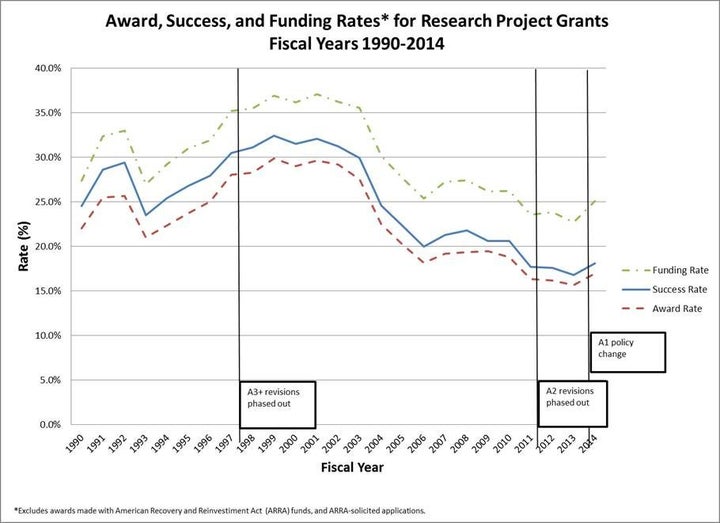During his final State of the Union address Tuesday night, President Barack Obama charged his vice president with spearheading a “moonshot” endeavor to cure cancer. He also asked the American people to support the effort in honor of their family members who have died from the aggressive and multifarious disease.
Indeed, Vice President Joe Biden is intimately familiar with the pain of losing a family member to cancer, a leading cause of death around the globe that kills approximately 8 million people every year. Tuesday night's announcement came about seven months after the death of Biden's son, Beau, from brain cancer.
And in characteristic self-effacement, Biden quipped the next morning to ABC’s Robin Roberts that he’s “not exactly sure what [the mission] entails." Of course, Biden's joke doesn't give credit to his lifetime of cancer advocacy. Nor does it acknowledge the summit of top cancer researchers he convened in the days before Obama made the announcement.
But it got us thinking -- how, exactly, is the U.S. going to accomplish this? HuffPost asked leading cancer research organizations, scientists and doctors what they want us to know about the mission to cure cancer.
1. This is an achievable goal.
Even now, the notion that we could “cure cancer” may seem naively optimistic or absurd. But the doctors and scientists in the trenches of cancer treatment are quite confident this could actually happen -- provided the U.S. is as committed and faithful to the cause for the long haul as we seem to be this week.
"It’s not pie in the sky,” said Dr. Clifford A. Hudis, chief of breast medicine service at Memorial Sloan Kettering Cancer Center. “There’s [already] a groundswell of new kinds of drugs that are making life better, even if they’re not curing people.”
Scientists have already vastly transformed the experience of a handful of cancers. Take chronic myelogenous leukemia: Before, a person would have to get chemotherapy and a bone marrow transplant, whereas now they pop a pill called Gleevec that transforms the cancer into a chronic disease. And certain types of breast cancers can either be completely cured or treated so that people can live with the tumors for a long time.
Dr. Peter Carroll, an associate director at the University of California, San Francisco’s Helen Diller Family Comprehensive Cancer Center, remembers when President Richard Nixon first declared “war" on cancer in 1971, and echoed Hudis' statements. While the limited knowledge of cancer at the time meant Nixon's war couldn't exactly be tactical, this one can be.
“We don’t have all the answers, but we have insights now that we’ve never had before, and the pace of research is exponential,” said Carroll. "Fully understanding cancer as a spectrum of disease, we will cure cancers that were not curable, understand cancers that don’t need to be cured, and think of cancer like heart disease or diabetes and match the treatment to the tumor."
2. We're going to need waaaaaaaaay more money.
Last December, the National Institutes of Health secured an extra $2 billion in general funding. While it was a nice shot in the arm for the agency in charge of funding medical research, scientists are going to need a lot more money than that to carry out the experiments needed to cure cancer.
At about 6.6 percent of the its current budget, the extra $2 billion represents the biggest funding increase in 12 years for the NIH, but quickly spreads thin when distributed across many research projects and administrative costs. Experts that spoke to HuffPost were quick to point out that the NIH’s spending power had stagnated for a decade or so after the agency's last big increase.
“If your salary was slack for 10 years and you got a 10 percent increase, would you conclude that you’re doing well?” asked Hudis.
The likelihood of any project or idea getting funded reached a historic low in 2013, thanks to the budget cuts the NIH suffered during sequestration that year. The success rates are only now just starting to tick back up.

Jon Retzlaff, science policy director for the American Association for Cancer Research, says that predictable, yearly budget increases of at least seven percent -- not random injections of big money -- is the best way to both account for inflation and send a signal to scientists that there is money and support for their ideas.
“Congress needs to appropriate robust funding increases that are sustained and predictable,” said Retzlaff. “Then you’d have young young researchers and young investigators saying, ‘You know what? I can have a career in this area,’ because they know there’s a chance their grant is going to be funded."
3. Researchers have to start playing nice.
The dearth of funding for scientific research puts an extra squeeze on researchers to remain “competitive,” which is why they’re loathe to share their hard-won data and insights with colleagues at other institutions. And that holds scientific discovery back, says Dr. Otis Brawley, chief medical officer of the American Cancer Society.
"In some instances, experiments that have been done are being repeated by other people because they can’t get access to that information,” he said. “That means research becomes duplicative and less efficient."
There is already some evidence Biden plans to tackle this particular issue; data-sharing programs were one of two “quick-payoff initiatives” discussed at the cancer researchers summit he hosted a few days before the State of the Union, reports Stat.
4. We have to stop treating cancer patients differently.
Curing cancer means curing individuals. But the sad truth about cancer treatment in America is that although we already have a lot of the resources to cure disease, or at least make them more manageable and less painful, the latest technological and medical advances aren’t always getting to the people who need them most thanks to a complex mix of racial and social inequalities.
For instance, while most cancers among women occur in whites, black women are most likely to die of their disease. And while cancer rates are equal among both the poor and the wealthy, poor people tend to get the most serious kinds of cancer and are more likely to die. Generally, only 41 percent of women with ovarian cancer are getting a strongly recommended treatment that can raise the survival rate 10 points, according to one 2015 study. Another found that 14 percent of early-stage breast cancer patients aren’t getting a certain kind of radiation treatment that takes fewer weeks to complete, thus reducing toxicity.
"The reason we’re not the number one country in terms of cancer mortality is a lot of the fruits of research that we’ve had over the last 30-40 years, we in the U.S. have a unique difficulty in getting those to the people," Brawley said, calling the issue an “American logistical problem."
"Science has told us this is a problem, but the American people, and especially the politicians, have not been willing to listen," he said. Now that there’s extra attention and excitement about this issue, Brawley is hoping that will change.
"If everybody stands up and says we’re interested in curing cancer or controlling cancer, maybe people will listen and realize that’s where we need to start,” he said.
5. A singular "cure" for cancer suggests all cancer is the same. It isn't.
What we call cancer is actually over 200 different diseases with one thing in common: uncontrolled cell growth. That’s why we may expect to completely cure one kind of cancer, but for another type we only expect to be able to keep it at bay.
And according to some emerging research, there will be some cancers that we don’t have to treat at all, explained Carroll.
"For some cancers we don’t need to cure it, we just need to understand it,” said Carroll. “Some examples of these are types of low-stage prostate cancer, early breast cancers and thyroid cancer that gets picked up by screening.”
Also on HuffPost:
